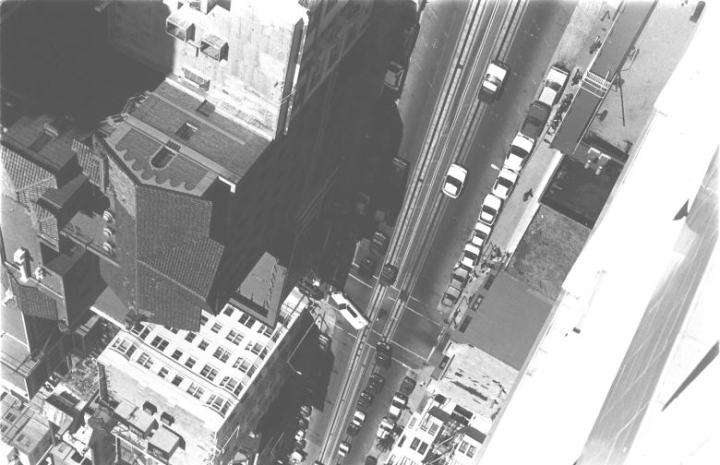SIDE/WALK/SHUTTLE (Ernie Gehr, 1991, USA)
 I recently got to have the chance to see Ernie Gehr present two of his most famous works at the Museum of Modern Art, including a remastered, 35mm blow-up of his seminal film from the 70’s, SERENE VELOCITY. I was more excited to view for the second time his later (made in the 90’s), and for me, superior and without all that baggage, film SIDE/WALK/SHUTTLE.
I recently got to have the chance to see Ernie Gehr present two of his most famous works at the Museum of Modern Art, including a remastered, 35mm blow-up of his seminal film from the 70’s, SERENE VELOCITY. I was more excited to view for the second time his later (made in the 90’s), and for me, superior and without all that baggage, film SIDE/WALK/SHUTTLE.
Like much of Gehr’s work, the film is a carefully constructed, determinedly minimalist example of the kind of work that helped define the Structural Film style. The thing that I find uncommonly memorable in Gehr’s films from this movement, however, is the inescapable human element he imbued in them—by way of a seeking, often hand-held camera; simple, almost rote, editing; and his intuitive, environmentally-informed, shooting strategy. To hear Gehr speak about his work, he almost uses his amateurism as a technique, a way to avoid the common traps of movie-making, and to create a unique cinematic experience. And when his technique is at full blossom, which I believe it is in this film, he creates a distinctly human-formed space that’s easy to get lost in.
The film is near an hour of footage shot from inside a glass elevator, and the resulting view is one of a cityscape in constant flux—with perspective, scale, and direction being shifted, reversed, slanted. It’s an exhilarating and disorienting study in slow-motion weightlessness, as the elevator travels up and down, and the camera holds on certain angles, or follows buildings, or engages in subtle shifts. It all combines to make a gravity-defying space impossible to ground oneself in.
Although the film looks very structured, Gehr stressed his open-ended work methods. Driven by necessity, he described smuggling his camera aboard the elevator, and working from makeshift notes jotted down on previous rides. “If you try to control everything in the frame,” he said during the Q & A session, “you create a dead work to start with.” He went on to encourage one to let a film “breathe,” and to remain open to accidents. It is this mindset, I believe, which make Gehr’s contribution to Structual Film, and American filmmaking at large, so devastatingly affecting.
leave a comment